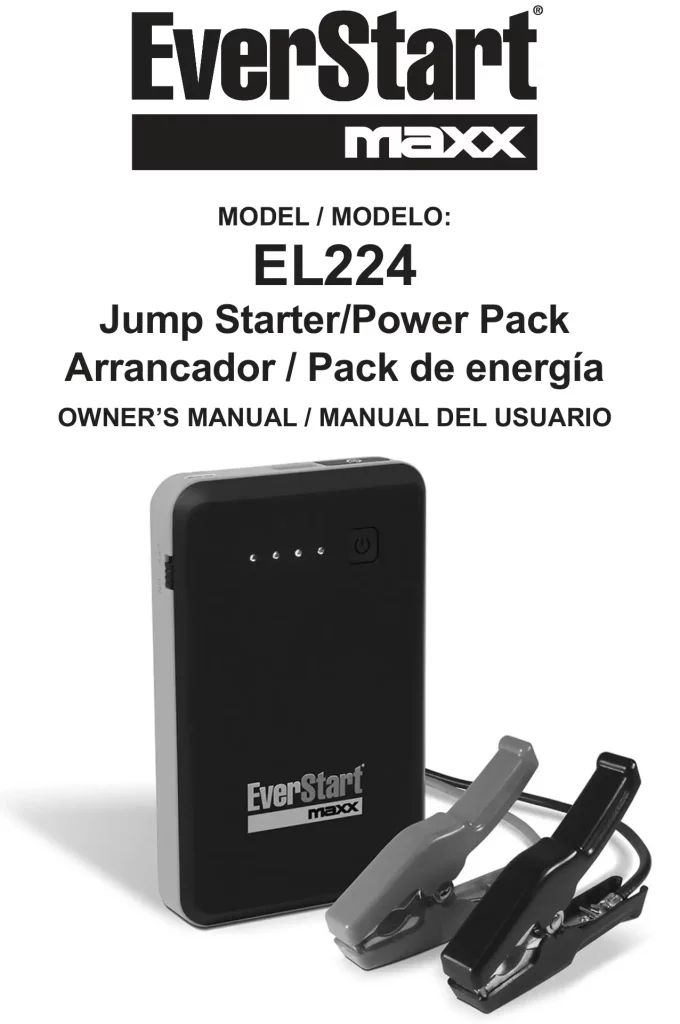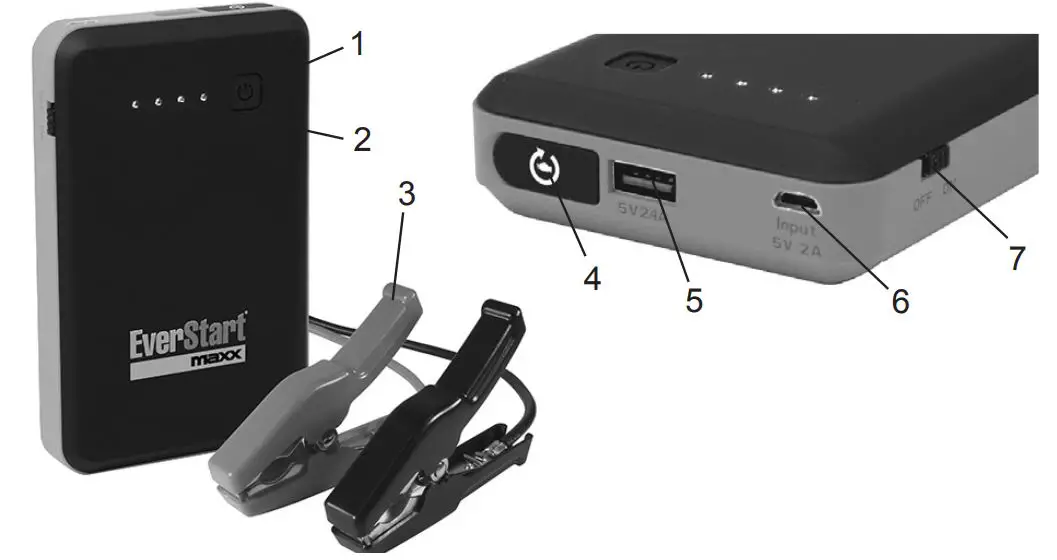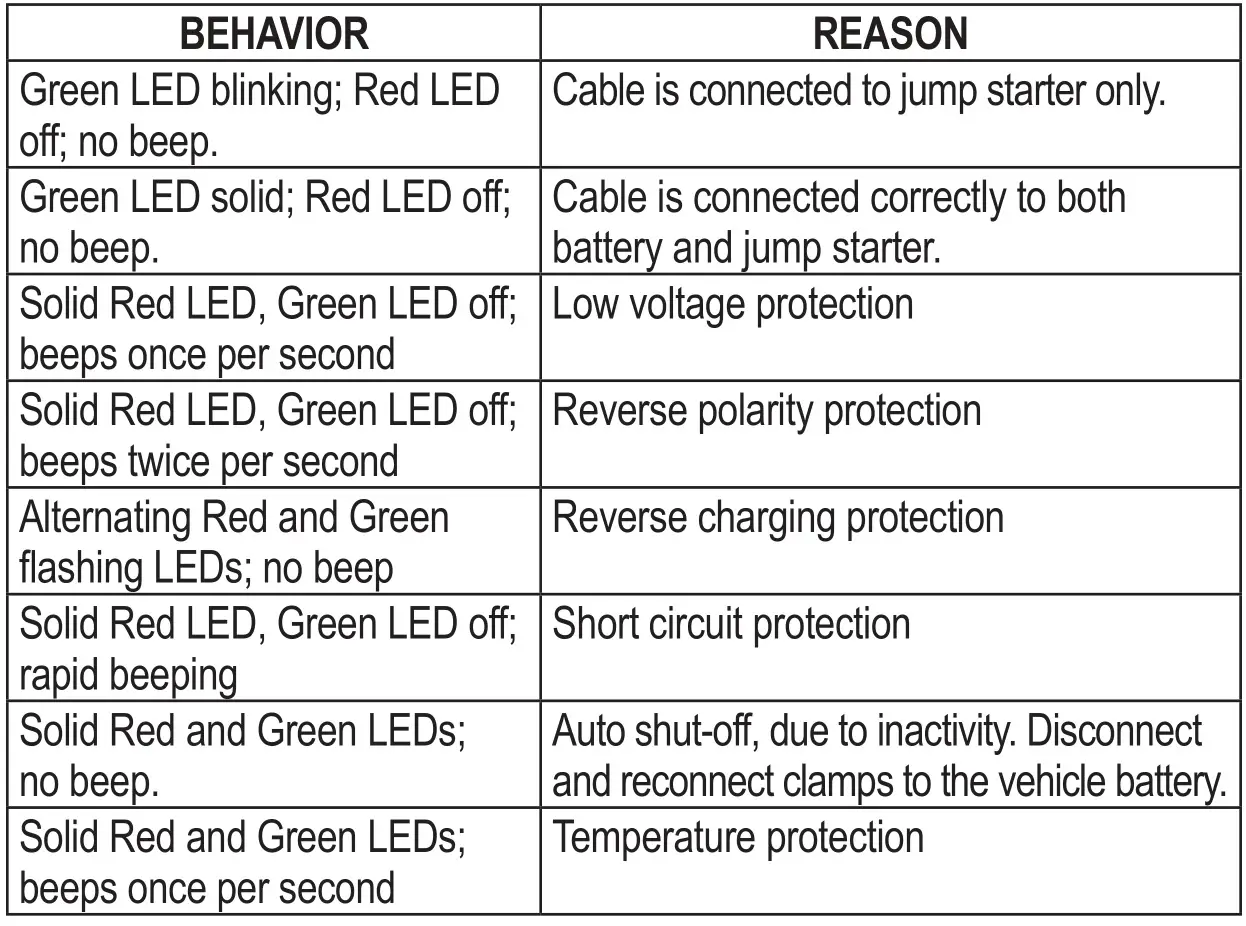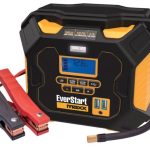
EverStart EL224 600 Peak AMP Lithium-Ion Jump Starter/Power Pack Owner's Manual

PLEASE SAVE THIS OWNER’S MANUAL AND READ BEFORE EACH USE. This manual will explain how to use the unit safely and effectively. Please read and follow these instructions and precautions carefully.
IMPORTANT SAFETY INSTRUCTIONS
SAVE THESE INSTRUCTIONS.
WARNING – RISK OF EXPLOSIVE GASES.
WORKING IN THE VICINITY OF A LEAD-ACID BATTERY IS DANGEROUS. BATTERIES GENERATE EXPLOSIVE GASES
DURING NORMAL OPERATION. IT IS IMPORTANT THAT YOU FOLLOW THESE INSTRUCTIONS EACH TIME YOU USE THE UNIT.
To reduce the risk of battery explosion, follow these instructions and those published by the battery manufacturer and the manufacturer of any equipment you intend to use in the vicinity of a battery. Review cautionary markings on these products and on the engine.
WARNING! RISK OF ELECTRIC SHOCK OR FIRE.
1.1 Read the entire manual before using this product. Failure to do so could result in serious injury or death.
1.2 Keep out of reach of children.
1.3 Do not put fingers or hands into any of the unit’s outlets.
1.4 Do not expose the unit to rain or snow.
1.5 Use only recommended attachments (SA892 jump cable). Use of an attachment not recommended or sold by the jump starter manufacturer for the EL224 may result in a risk of fire, electric shock or injury to persons or damage to property.
1.6 To reduce the risk of damage to the electric plug or cord, pull by the adaptor rather than the cord when disconnecting the unit.
1.7 Do not operate the unit with damaged cables or clamps.
1.8 Do not operate the unit if it has received a sharp blow, been dropped or otherwise damaged in any way; take it to a qualified service person.
1.9 Do not disassemble the unit; take it to a qualified service person when service or repair is required. Incorrect reassembly may result in a risk of fire or electric shock.
1.10 Changes or modifications not expressly approved by the party responsible for compliance could void the user’s authority to operate this device.
WARNING! RISK OF EXPLOSIVE GASES.
1.11 To reduce the risk of a battery explosion, follow these instructions and those published by the battery manufacturer and the manufacturer of any equipment you intend to use in the vicinity of the battery. Review the cautionary markings on these products and on the engine.
1.12 Do not set the unit on flammable materials, such as carpeting, upholstery, paper, cardboard, etc.
1.13 Never place the unit directly above battery being jumped.
1.14 Do not use the unit to jump start a vehicle while charging the internal battery.
PERSONAL PRECAUTIONS
WARNING! RISK OF EXPLOSIVE GASES. A SPARK NEAR THE BATTERY MAY CAUSE A BATTERY EXPLOSION. TO REDUCE THE RISK OF A SPARK NEAR THE BATTERY:
2.1 NEVER smoke or allow a spark or flame in the vicinity of a battery or engine.
2.2 Remove personal metal items such as rings, bracelets, necklaces and watches when working with a lead-acid battery. A lead-acid battery
can produce a short-circuit current high enough to weld a ring to metal, causing a severe burn.
2.3 Be extra cautious, to reduce the risk of dropping a metal tool onto the battery. It might spark or short-circuit the battery or other electrical part that may cause an explosion.
2.4 Do not permit the internal battery of the unit to freeze. Never charge a frozen battery.
2.5 To prevent sparking, NEVER allow clamps to touch together or contact the same piece of metal.
2.6 Consider having someone nearby to come to your aid when you work near a lead-acid battery.
2.7 Have plenty of fresh water, soap and baking soda nearby for use, in case battery acid contacts your eyes, skin, or clothing.
2.8 Wear complete eye and body protection, including safety goggles and protective clothing. Avoid touching your eyes while working near the battery.
2.9 If battery acid contacts your skin or clothing, immediately wash the area with soap and water. If acid enters your eye, immediately
flood the eye with cold running water for at least 10 minutes and get medical attention right away.
2.10 If battery acid is accidentally swallowed, drink milk, the whites of eggs or water. DO NOT induce vomiting. Seek medical attention immediately.
2.11 Neutralize any acid spills thoroughly with baking soda before attempting to clean up.
2.12 This product contains a lithium ion battery. In case of fire, you may use water, a foam extinguisher, Halon, CO2, ABC dry chemical, powdered graphite, copper powder or soda (sodium carbonate) to extinguish the fire. Once the fire is extinguished, douse the
product with water, an aqueous-based extinguishing agent, or other nonalcoholic liquids to cool the product and prevent the battery from
re-igniting. NEVER attempt to pick up or move a hot, smoking, or burning product, as you may be injured.
2.13 NOTE: This equipment has been tested and found to comply with the limits for a Class B digital device, pursuant to part 15 of the FCC Rules. These limits are designed to provide reasonable protection against harmful interference in a residential installation. This equipment generates, uses, and can radiate radio frequency energy and, if not installed and used in accordance with the instructions, may cause harmful interference to radio communications. However, there is no guarantee that interference will not occur in a particular installation. If this equipment does cause harmful interference to radio or television reception, which can be determined by turning the equipment off and on, the user is encouraged to try to correct the interference by one or more of the following measures:
- Reorient or relocate the receiving antenna.
- Increase the separation between the equipment and receiver.
- Connect the equipment into an outlet on a circuit different from that to which the receiver is connected.
- Consult the dealer or an experienced radio/TV technician for help
PREPARING TO USE THE UNIT
WARNING! RISK OF CONTACT WITH BATTERY ACID. BATTERY ACID IS A HIGHLY CORROSIVE SULFURIC ACID.
3.1 Make sure the area around the battery is well ventilated while the unit is in use.
3.2 Clean the battery terminals before using the jump starter. During cleaning, keep airborne corrosion from coming into contact with your eyes, nose and mouth. Use baking soda and water to neutralize the battery acid and help eliminate airborne corrosion. Do not touch your eyes, nose or mouth.
3.3 Determine the voltage of the battery by referring to the vehicle owner’s manual and make sure that the output voltage is 12V.
3.4 Make sure that the unit’s cable clamps make tight connections.
FOLLOW THESE STEPS WHEN CONNECTING TO A BATTERY
WARNING! A SPARK NEAR THE BATTERY MAY CAUSE A BATTERY EXPLOSION. TO REDUCE THE RISK OF A SPARK NEAR THE BATTERY:
4.1 Plug the clamps into the unit, and then attach the output cables to the battery and chassis as indicated below. Never allow the output clamps to touch each other.
4.2 Position the DC cables to reduce the risk of damage by the hood, door and moving or hot engine parts. NOTE: If it is necessary to close the hood during the jump starting process, ensure that the hood does not touch the metal part of the battery clips or cut the insulation of the cables.
4.3 Stay clear of fan blades, belts, pulleys and other parts that can cause injury.
4.4 Check the polarity of the battery posts. The POSITIVE (POS, P, +) battery post usually has a larger diameter than the NEGATIVE (NEG, N, -) post.
4.5 Determine which post of the battery is grounded (connected) to the chassis. If the negative post is grounded to the chassis (as in most
vehicles), see step 4.6. If the positive post is grounded to the chassis, see step 4.7.
4.6 For a negative-grounded vehicle, connect the POSITIVE (RED) clamp from the jump starter to the POSITIVE (POS, P, +) ungrounded post of the battery. Connect the NEGATIVE (BLACK) clamp to the vehicle chassis or engine block away from the battery. Do not connect the clamp to the carburetor, fuel lines or sheet-metal body parts. Connect to a heavy gauge metal part of the frame or engine block.
4.7 For a positive-grounded vehicle, connect the NEGATIVE (BLACK) clamp from the jump starter to the NEGATIVE (NEG, N, -) ungrounded post of the battery. Connect the POSITIVE (RED) clamp to the vehicle chassis or engine block away from the battery. Do not connect the clamp to the carburetor, fuel lines or sheet-metal body parts. Connect to a heavy gauge metal part of the frame or engine block.
4.8 When finished using the jump starter, remove the clamp from the vehicle chassis and then remove the clamp from the battery terminal. Disconnect the clamps from the unit.
FEATURES

- Power Level button
- Power level LEDs
- Battery clamps with smart cable
- Jump start output socket
- USB output port
- Micro USB Input port for recharging
- ON/OFF switch Not shown:
- LED light (on back)
- Micro USB-USB charging cable
- Carrying bag
CHARGING THE JUMP STARTER
IMPORTANT! CHARGE IMMEDIATELY AFTER PURCHASE, AFTER EACH USE AND EVERY 30 DAYS, OR WHEN THE
CHARGE LEVEL FALLS BELOW 75%, TO KEEP THE INTERNAL BATTERY FULLY CHARGED AND PROLONG BATTERY LIFE.
6.1 CHECKING THE LEVEL OF THE INTERNAL BATTERY
- Slide the ON/OFF switch to the ON position. Press the
 Power Level button on the front of the unit. The number of LEDs lit indicates
Power Level button on the front of the unit. The number of LEDs lit indicates
the charge level:
● ● ● ● 100% charged
● ● ● 75% charged
● ● 50% charged
● 25% charged
Charge the internal battery if the LEDs indicate less than 75% - To reduce the risk of electric shock, unplug the unit’s charging cable from a USB or wall charger before attempting any maintenance or cleaning. Simply turning off the controls will not reduce this risk.
- When charging the internal battery, work in a well ventilated area and do not restrict the ventilation in any way
6.2 CHARGING THE INTERNAL BATTERY
NOTE: Use a 2A USB charger (sold separately) or a USB charging port to quickly recharge the jump starter. Using a charger with less than 2A will increase charge time.
- Plug the Micro USB end of the charging cable into the input port. Next, plug the USB end of the charging cable into a charger’s USB port.
- Plug your charger into a live AC or DC power outlet.
- The jump starter will fully charge in approximately 4 hours (with 2A charger). When the unit is fully charged, all four blue LEDs turn solid for a short time, and then shut off.
- When the battery is fully charged, disconnect your charger from the outlet, and then remove the charging cable from the charger and the unit. Slide the ON/OFF switch to the OFF position, if you are not using the unit immediately.
OPERATING INSTRUCTIONS
7.1 JUMP STARTING A VEHICLE ENGINE
NOTE: Use only model number SA892 jump cable.
IMPORTANT: Do not use the jump starter while charging its internal battery.
IMPORTANT: Using the jump starter without a battery installed in the vehicle will damage the vehicle’s electrical system.
NOTE: The internal battery must have a charge if at least 50% to jump start a vehicle.
- Turn the ignition OFF.
- Plug the battery clamp cable into the jump starter’s output socket.
- Lay the DC cables away from any fan blades, belts, pulleys and other moving parts. Make sure all of the vehicle’s electrical devices are turned off.
- For a negative-grounded vehicle, connect the POSITIVE (RED) clamp from the jump starter to the POSITIVE (POS, P, +) ungrounded post of the battery. Connect the NEGATIVE (BLACK) clamp to the vehicle chassis or engine block away from the battery. Do not connect the clamp to the carburetor, fuel lines or sheet-metal body parts. Connect to a heavy gauge metal part of the frame or engine block.
- For a positive-grounded vehicle, connect the NEGATIVE (BLACK) clamp from the jump starter to the NEGATIVE (NEG, N, -) ungrounded post of the battery. Connect the POSITIVE (RED) clamp to the vehicle chassis or engine block away from the battery. Do not connect the clamp to the carburetor, fuel lines or sheet-metal body parts. Connect to a heavy gauge metal part of the frame or engine block.
- Slide the ON/OFF switch to the ON position. The green LED should light.
NOTE: If the vehicle battery is extremely discharged, the initial current draw from the jump starter may activate short circuit protection in the smart cable. When the condition is corrected, the smart cable will automatically reset. - After a proper connection has been made, crank the engine. If the engine does not start within 3 seconds, stop cranking and wait at least 1 minute before attempting to start the vehicle again.
NOTE: If the car does not crank a second time, check the smart cable to see if the green LED is lit. If you hear beeping or an LED is flashing, refer to section 10, Troubleshooting. When the condition is corrected, the smart cable will automatically reset.
NOTE: Cold weather may affect the performance of the jump starter’s lithium battery. If you hear only a click and the engine does not turn over, try the following: With the jump starter connected to the car battery and the green LED illuminated on the smart cable, turn on all lights and electrical accessories for one minute. This draws current from the jump starter and warms the battery. Now try to crank the engine. If it does not turn over, repeat the procedure. Extremely cold weather may require two or three battery warmings before the engine will start.
NOTE: If no activity is detected, the smart cable will automatically shut off after 120 seconds, and the red and green LEDs will be solid. To reset, disconnect the clamps from the vehicle battery, and then reconnect.
IMPORTANT: DO NOT attempt to jump start your vehicle more than three consecutive times. If the vehicle will not start after three attempts, consult a service technician. - After the engine starts, unplug the battery clamps from the jump starter socket and then disconnect the black clamp (-) and the red clamp (+), in that order. Slide the ON/OFF switch to the OFF position.
- Recharge the unit as soon as possible after each use.
7.2 CHARGING A MOBILE DEVICE WITH THE USB PORT
The USB port provides up to 2.4A at 5V DC.
- Plug a charging cable into the input port of your mobile device. Next, plug the USB end of the charging cable into the jump starter’s USB port.
- Slide the ON/OFF switch to the ON position. Charging should begin automatically.
- Charging time will vary, based on the mobile device’s battery size.
- When finished using the USB port, disconnect the charging cable from your mobile device and then disconnect the charging cable from the unit. Slide the ON/OFF switch to the OFF position.
- Recharge the unit as soon as possible after each use.
NOTE: If no USB device is connected, power to the USB port will automatically shut off after 30 seconds.
7.3 USING THE LED LIGHT
- Slide the ON/OFF switch to the ON position.
- Hold down the
 button for 3 seconds.
button for 3 seconds. - Once the LED light is on, press and release the
 button to cycle through the following modes:
button to cycle through the following modes:
• Steady glow
• Flash for an SOS signal
• Flash in strobe mode - When finished using the LED light, press and hold the
 button until the light turns off.
button until the light turns off. - Slide the ON/OFF switch to the OFF position.
- Recharge the unit as soon as possible after each use.
MAINTENANCE INSTRUCTIONS
- After use and before performing maintenance, unplug and disconnect the unit.
- Use a dry cloth to wipe all battery corrosion and other dirt or oil from the battery clamps, cords, and the outer case.
- Do not open the unit, as there are no user-serviceable parts.
STORAGE INSTRUCTIONS
- Charge battery to full capacity before storage.
- Store this unit at temperatures between -4°F-+140°F (-20°C-+60°C).
- Never completely discharge the battery.
- Charge after each use.
- Charge at least once every month, if not in frequent use, to prevent over-discharge.
TROUBLESHOOTING
Jump Starter

Smart Cable LED and Alarm Behavior

NOTE: When the condition is corrected, the smart cable will automatically reset
SPECIFICATIONS
Internal battery type …………………………………… Lithium ion polymer
Capacity …………………………………………………………………. 26.64 Wh
USB output…………………………………………………………..5V DC, 2.4A
Jump start …………………………………………600A peak/300A cranking
Charging Temperature………………………………. 32°-122°F (0°-50°C)
REPLACEMENT PARTS
Battery clamps/smart cable…………………………………….. 94500892Z
Micro USB-USB charging cable …………………………… 3899003781Z
BEFORE RETURNING FOR REPAIRS
For REPAIRS OR RETURNS, visit 365rma.com
Visit batterychargers.com for Replacement Parts.
LIMITED WARRANTY
For information on our one year limited warranty, please visit batterychargers.com or call 1-800-621-5485 to request a copy.
Go to batterychargers.com to register your product online.
